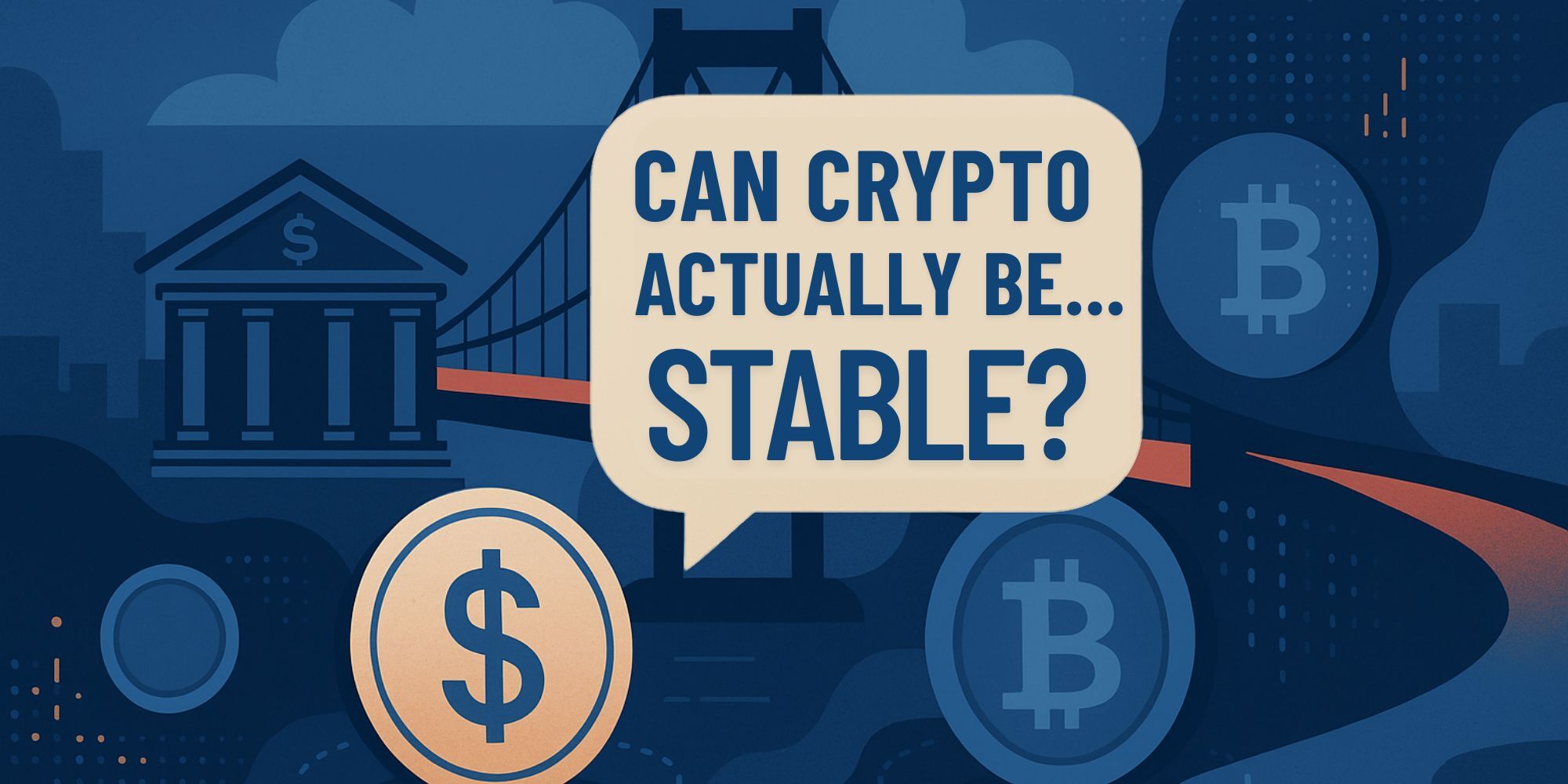Stablecoins Explained: How They Work and Why the Wealthy Are Paying Attention
Cryptocurrencies have revolutionized the financial world by offering innovative ways to transfer value, store wealth, and build new financial systems. However, the extreme volatility that characterizes most cryptocurrencies can pose significant challenges for many investors, particularly those seeking stability and predictability in their portfolios.
Enter stablecoins - a special category of digital assets designed to maintain a stable value, typically pegged to traditional fiat currencies like the U.S. dollar. As a bridge between conventional finance and the crypto ecosystem, stablecoins enable investors and businesses to enjoy the benefits of digital currencies without the wild price swings common to Bitcoin or Ethereum.
This article provides a comprehensive guide to stablecoins, explaining how they work, why they matter, their associated risks, and how you can thoughtfully incorporate them into your wealth management strategy with cryptocurrency.
What Are Stablecoins?
At the simplest level, stablecoins are cryptocurrencies that aim to maintain a stable value relative to an underlying asset - most often a fiat currency such as the U.S. dollar, Euro, or even commodities like gold.
Unlike traditional cryptocurrencies, whose prices are driven by market demand and supply and can be highly volatile, stablecoins aim to provide a reliable and consistent value. This stability makes them ideal for a variety of use cases, including trading, payments, and as a store of value within the digital economy.
The Different Types of Stablecoins
Stablecoins come in various forms, each with distinct mechanisms to maintain their peg. Understanding these types is crucial for evaluating their benefits and risks.
| Type | Backing Mechanism | Examples | Pros | Risks |
|---|---|---|---|---|
| Fiat-Collateralized | Backed 1:1 by fiat in bank accounts | USDT, USDC | Simple, liquid, widely accepted | Trust in custodians; regulatory pressure |
| Crypto-Collateralized | Backed by crypto held in smart contracts | DAI | Decentralized, transparent | Volatility of collateral; smart contract risk |
| Algorithmic | Supply adjusted via algorithm | UST (defunct), others in DeFi | No reserves needed, capital-efficient | Unstable; prone to collapse |
1. Fiat-Collateralized Stablecoins
These stablecoins are backed 1:1 by fiat currency reserves held in bank accounts or other liquid assets. For every stablecoin issued, an equivalent amount of fiat currency is held in custody, theoretically ensuring that holders can redeem their tokens at any time for the corresponding fiat currency.
Examples:
- Tether (USDT): The largest and most widely used stablecoin by trading volume. USDT maintains its peg through reserves of dollars and other assets.
- USD Coin (USDC): Known for its transparency, USDC regularly publishes audits of its reserves, increasing investor confidence.
Advantages:
- Simple and intuitive peg mechanism
- High liquidity and acceptance across exchanges
- Familiarity for investors and regulators
Risks:
- Reliance on trusted custodians and audits
- Potential regulatory scrutiny regarding reserve management
2. Crypto-Collateralized Stablecoins
Rather than holding fiat reserves, these stablecoins are backed by other cryptocurrencies deposited in smart contracts. To protect against volatility, they are often over-collateralized - meaning the value of the collateral exceeds the amount of stablecoins issued.
Example:
Dai (DAI): Created by MakerDAO, DAI is backed by a variety of cryptocurrencies, including Ethereum, which are locked in decentralized vaults.
Advantages:
- Fully decentralized and transparent
- Reduced reliance on traditional banking infrastructure
- Supports the ethos of decentralization
Risks:
- Collateral value volatility during market crashes
- Smart contract risks, bugs, or exploits
3. Algorithmic Stablecoins
These stablecoins are not backed by collateral but instead utilize algorithms and protocols that automatically adjust the supply to maintain the peg, similar to a central bank's monetary policy.
Examples:
TerraUSD (UST) - historically notable but has experienced high-profile failure.
Advantages:
- No need for collateral reserves - potentially more capital efficient
- Can be fully decentralized
Risks:
- Highly experimental - prone to collapse during stress
- Dependent on user confidence and market dynamics
Why Stablecoins Are Transforming Finance
Stability in a Volatile Market
The cryptocurrency market is known for its dramatic price swings. Stablecoins offer a refuge - allowing investors to stay in crypto without riding the rollercoaster.
Enhancing Trading and Liquidity
Stablecoins are the most common trading pair across exchanges. They make it easier and faster to buy, sell, and rebalance digital assets without going back to fiat.
Facilitating Cross-Border Payments
Businesses and individuals are using stablecoins to bypass the fees and delays of international wire transfers. Stablecoins make payments faster, cheaper, and easier to track.
Driving DeFi Innovation
Stablecoins are the backbone of DeFi. They fuel lending protocols, yield farming, and synthetic asset platforms that bypass traditional banks and intermediaries.
Risks and Considerations of Stablecoins
- Counterparty Risk: Are the reserves real? Are the audits reliable?
- Regulatory Uncertainty: Governments are still figuring out how to regulate stablecoins
- Smart Contract Risk: If it's on-chain, it can be hacked
- Liquidity Risk: Under stress, some stablecoins lose their peg
We help clients manage exposure and custody risk when integrating stablecoins into broader crypto wealth strategies.
Practical Applications for VIP Clients
- Cash Management: Keep dry powder in stablecoins to deploy quickly across crypto or traditional markets
- Portfolio Hedging: Reduce crypto exposure temporarily without going back to fiat
- Business Payments: Faster, cheaper global settlement for entrepreneurs and digital nomads
- DeFi Yield: Generate income using stablecoins in vetted protocols (with guardrails)
Due Diligence: How to Evaluate Stablecoins
- Check for regular third-party audits
- Understand how redemptions work
- Assess reserve custody and transparency
- Evaluate smart contract risks if using crypto-backed coins
- Stay informed about regulations and compliance updates
The Future of Stablecoins and Crypto Finance
Central Bank Digital Currencies (CBDCs) are on the horizon. But stablecoins are already live, liquid, and used at scale.
We expect greater regulatory clarity, more institutional use, and deeper integration into traditional finance. High-net-worth investors should monitor this shift and prepare accordingly.
Conclusion
Stablecoins stand at the intersection of innovation and stability. They offer flexibility, liquidity, and utility - without the volatility of typical cryptocurrencies.
But like any tool, they require education and due diligence. At VIP Wealth Advisors, we help clients explore crypto strategies that fit their goals, risk tolerance, and long-term plan.
📅 Schedule a free consultation to review your crypto wealth strategy.
Bonus! Stablecoin FAQs
-
What exactly is a stablecoin?
A stablecoin is a type of cryptocurrency designed to maintain a stable value, usually pegged 1:1 to a fiat currency like the U.S. dollar. It combines the benefits of digital currency with price stability.
-
How do stablecoins maintain their $1 peg?
They do this through different mechanisms: fiat reserves backing each coin, collateralized cryptocurrencies locked in smart contracts, or algorithmic adjustments to supply.
-
Are stablecoins safe investments?
While generally less volatile than traditional cryptocurrencies, stablecoins carry risks including counterparty risk, regulatory uncertainty, and technological vulnerabilities. Due diligence is essential.
-
Can I use stablecoins for payments or business transactions?
Yes. Stablecoins enable fast, low-cost, and cross-border payments, streamlining international business operations.
-
What role do stablecoins play in portfolio management?
They can be used to hedge against crypto volatility, maintain liquidity, and gain exposure to DeFi yield opportunities while managing risk.
-
How can I buy or sell stablecoins?
Stablecoins are widely available on crypto exchanges. For large transactions, working with a trusted advisor or brokerage ensures compliance and the best execution.
Bonus! Risk Checklist for Stablecoin Use
✅ Verify transparency: Are reserve audits publicly available and credible?
✅ Assess the credibility of custodians for fiat-backed coins.
✅ Understand the redemption process and liquidity constraints.
✅ Review the smart contract audit status for crypto-backed coins.
✅ Monitor regulatory updates that may impact stablecoin operations.
✅ Be cautious with algorithmic stablecoins given their higher risk profile.
✅ Limit exposure to stablecoins to an appropriate portion of your portfolio.
✅ Maintain secure storage and use trusted platforms for transactions.
Bonus! Tailored Investment Scenarios Featuring Stablecoins
Scenario A: Portfolio Hedging During Volatile Markets
You hold a mix of cryptocurrencies but want to reduce risk during a turbulent period. Converting a portion into a fiat-backed stablecoin, such as USDC, allows you to “park” value on-chain with minimal volatility and redeploy it quickly when conditions improve.
Scenario B: Cross-Border Business Payment Solution
Your business regularly pays international contractors. Using stablecoins reduces transfer times from days to minutes and lowers fees compared to wire transfers, improving cash flow management.
Scenario C: Accessing DeFi Yield Opportunities
By allocating a portion of your portfolio to stablecoins, you can explore vetted DeFi lending platforms that offer interest income. You diversify yields beyond traditional fixed income while maintaining capital stability.
View More Articles by Topic
- Taxes (76)
- Financial Planning (40)
- Equity Compensation (34)
- Investments (23)
- RSU (21)
- Tax Policy & Legislation (18)
- Business Owner Planning (15)
- Incentive Stock Options (14)
- Retirement (14)
- Psychology of Money (10)
- Alternative Investments (9)
- Real Estate (9)
- AMT (8)
- Pre-IPO Planning (8)
- Estate Planning (7)
- Fiduciary Standard (6)
- NSOs (6)
- The Boring Investment Strategy (6)
- Capital Gains Tax (5)
- Crypto (5)
- QSBS (5)
- Post-IPO Tax Strategy (4)
- 401(k) Strategy (3)
- Private Investments (3)
- Q&A (3)
- Charitable Giving (2)
- ETF Taxes (2)
- IRA Strategy (2)
- International Financial Strategies (2)
- Irrevocable Trust (2)
- Legacy Wealth (2)
- Market Insights (2)
- Market Timing (2)
- Stock Market (2)
- Venture Capital (2)
- Video (2)
- AUM vs Flat Fee (1)
- Altruist (1)
- Atlanta (1)
- Book Review (1)
- Depreciation & Deductions (1)
- Education Planning (1)
- Precious Metals (1)
- QTIP Trust (1)
- Revocable Trust (1)
- Schwab (1)
- Solo 401k (1)


.jpg)





